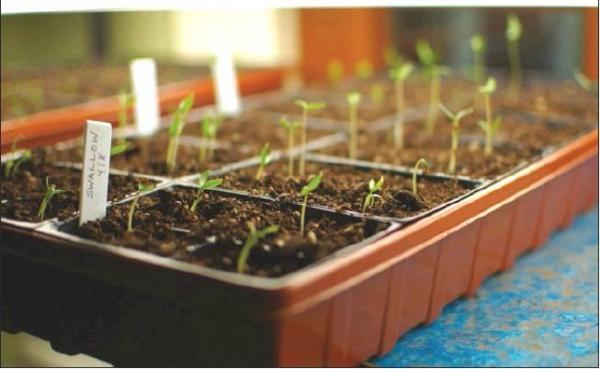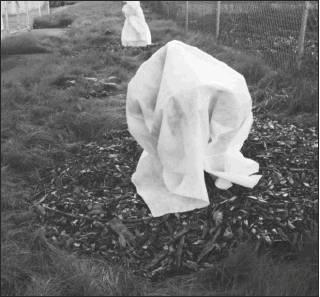Weathering our Weather
The media is buzzing with stories about ‘warmer than usual winter days. Just this past week, we had temperatures in the upper 70s! This is certainly nice for spending time outside, but what is the effect of long stretches of warm winter temperatures on garden plants and what can you do about it? Now that is a question that lots of folks are asking me. Here are a few tips and suggestions for adjusting your garden tasks to help your garden plants cozy up to the idea of unseasonably warm winter days; and you can even do them in your shorts and flip flops if you so choose!
Mike H. of Wimberley wrote me that he is concerned about his peach trees since they are beginning to bud really early. Fruit trees, for many of us, is a primary concern right now. We all dream of big beautiful juicy peaches in the summer, right? Take a close look at your stone fruit trees and you may notice that the buds on your trees are starting to swell and like Mike you wonder, is this a bad thing? Well the answer is, yes and no.
Yes, because when buds of early developing tree fruits like apricots, peaches, and sweet cherries, expand and develop earlier than usual, they become more vulnerable to damage from frost. Hence the ‘no’ part, if the temperatures stay mild, the flower buds will be just fine, bit a freeze could mean trouble. Certain fruit trees, like stone fruits – cherries, peaches, and apricots, typically set more flower buds than are really needed (I am always recommending thinning flower buds) so a few buds lost to frost can still yield in a good summer crop. However, if temperatures dip too low, like the teens or worse, this can mean serious trouble. The problem with warm weather in January or even February, is that we still have a lot of winter days to go until we are out of the woods. Here is a tip, watch temperature lows, and if temperatures dip below 30°F, cover vulnerable trees with a large blanket or tarp. This will not save your crop if the temperatures dip too low, like if it is in the teens for several hours, but it might help save your potential fruit load through a cold winter night or two.
You can find the critical temperatures for frost damage on fruit trees online for your specific variety. Bookmark the page when you find the one you like as it is a great resource for predicting bud kill at various temperature lows.
Laura O. In Dripping Springs sent a question in about pruning her fruit trees so since so many of us care so much about enjoying tree ripened fruit, I’ll stay on the topic of fruit trees for one more tip to answer Laura’s question. Typically, we would break out our pruning tools when flower buds begin to swell and start to snip away, thinning the buds so that the resulting fruit is not crowded on the branch. This means bigger fruit at harvest time. However, for years with weather like we are having this year, it may be hard to know how much damage has been done to flower buds. Here is my suggestion, just relax and wait a little while, at least until the flowers emerge and you can take a closer look searching for evidence of frost damage (brown or black tissue means some damage has taken place) in the flower center. If a large percentage of flower buds are damaged, prune them away but make sure to preserve (don’t prune off) those that do not show evidence of damage. Therefore, it makes sense to prune a little later (at bloom) than usual for early developing tree fruit like apricots, peaches, and sweet cherries during strange weather years.
My brother asked me during our New Year’s party if I thought it was a good idea to start the vegetable garden a bit early this year, considering the warmer temperatures. My suggestion to him, and to you, is to suppress your burning desire to plant your vegetable garden early. Warm weather in January or February does not necessarily mean temperatures will stay mild through spring.
Remember, gardeners plan vegetable garden planting times around the average last spring frost and warm winter weeks have no bearing on spring frost dates. So, what does that mean for us? Each winter, on average, our risk of frost is from December 6th through February 17th. Almost certainly, however, we will receive frost at some point from December 28th through January 23rd. We are almost guaranteed not to get frost from March 15th through November 14th. Our frostfree growing season runs around 292 days (which is a lot) so be patient and start your seeds inside instead – spring will come eventually.
Lloyd D of Kyle asked if it is too late to plant some new trees or bushes in his yard. Perhaps you weren’t able to find time in the fall to transplant a berry bush or purchase a new fruit tree, can you do it now during warm winter weather. The simple answer is yes. It’s not the best time because it is impossible to predict what the weather will do in the coming weeks. It is best to plant plants in unfrozen ground so they can immediately begin to grow roots into their new home. Even though the ground is not frozen this week, who knows about the next, so it is a little bit of a gamble. That being said, it is not a bad time because woody plants (trees and shrubs with wood) are in a dormant state. So, it’s up to you, as for me I would go for it! However, I would make sure to purchase plants that are adapted to local temperatures (that have been kept outside at a local nursery) as opposed to purchasing plants that have been shipped in from warmer climates. And as always, water newly planted or transplanted trees and shrubs into the soil immediately.
My wife, Holly, asked if this warmer than usual weather would mean potential pest problems are in our future. Well, one good thing about cold winter temperatures is that they can suppress certain populations of overwintering garden insect pests. Some insect pests, like aphids, are forced to overwinter as eggs in freezing temperatures. All is not lost though if winter temperatures stay mild, an unpredicted spring freeze can catch emerging pests off guard and suppress early populations. That means that this warmer weather might actually reduce pest problems later in the year – if we are fortunate!
Lastly, remember, no matter how hot it gets out there, stay cool! You can’t change the weather but you sure can get outside and enjoy it!




